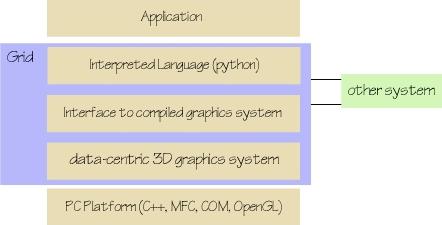Rich Gossweiler
current date
Grid:

A Quick Example of an Application Using Grid
To get some grounding, here is an example using a snipit of code that creates Grid-based 3D objects. The example is not complete, but it gives you the basic idea. It is written in C++ since that is what I am developing in right now, but you can imagine what the python version would look like.GridObject *root = GridDB::GetRoot(); GridCamera *camera = GridDB::GetCamera(); Grid3DGeom *ball = GridShape::CreateSphere(); // defaults to unit sphere Grid3DGeom *room = GridVRML::Load(root, "D:\room.wrl"); ball->makeChildOf(room); ball->setColor(GridColor::PUCE); ball->translateTo(1.0,0,0); // move to X=1.0 meters // Now you can do your application, and move the ball around // It is interesting to note that you can make the camera a // child of the ball and get a "ballCam" or you can make the // ball a child of the camera, and it will be part of the dashboard // (Head Up Display)
Grid Features
- Geometric primitives: Polygons, polylines, polypoints
- Text: 2.75D (screen-aligned, in-scene) and 3D text
- Object manipulation: 3D heirarchical model Transforms
- Wireframe
- Bounding Volumes
- 3D Object Abstraction
- Primitive and Parametric Shapes
- Switching/LOD
- Lighting
- Materials
- Color
- Translucency
- MFC integration
- Texture
- Fog
- Multiple Cameras and Viewports
- Audio
- Event Model
- Picking and Gestures
- Paths
- Keyframe Animation
- Behaviors
- import/export a subset of VRML 2.0
- COM interface: inter-application communication support
- Python integration
- plug-in architecture
Grid Inheritance
- GridNode
- GridArray
GridBBox
GridBV
GridColor
GridMaterial
GridMatrix
GridPoly
GridShape
GridStack
GridString
GridTranslucency
GridTree
- Grid3D
- Grid3DGeom
Grid3DText
GridLight
GridVRMLParser
GridVector3
GridLightArray
GridLog
GridRenderer
GridTokenizer
GridWebTexture
